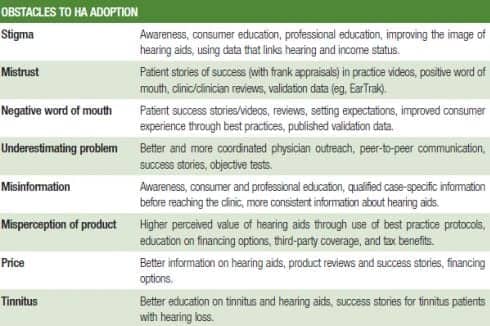by Markus L. Hilbert, AuD
Providing hearing health information through online communities creates fans, not just patients.

Are today’s professional hearing health care Web sites really paving the way for consumers to obtain appropriate hearing solutions? This article discusses the current landscape of online marketing and solutions for patient retention using key online tools and effective online patient referral strategies.
In Part 1 (April 2012 HR), we reviewed the obstacles in hearing aid adoption based on MarkeTrak research, and the solutions hearing care professionals need to provide online in order to help not-yet-users (NYUs) overcome these barriers (Table 1). Once we address these obstacles, the number of people ready to act (RTA) on their hearing loss and to get amplification will likely increase, which will benefit all hearing care providers. Your traditional marketing, focused on getting the RTAs in your own clinic, will then have a much higher return. Alternative marketing strategies, such as social media marketing and an active online presence, will then be your natural next step.
Briefly, let’s consider what a typical consumer might find when currently searching the Internet for hearing solutions.
Survey basics. This survey was designed to provide individual hearing practices with a benchmarking tool to compare their performance against industry standards. These statistics can be used as a basis for assessing and setting realistic, continuous, and fact-based improvement goals.
ONLINE OFFERINGS IN HEARING CARE
No matter how attractive manufacturer Web sites may look, they are naturally biased, focusing on specific products and basic clinic listings. While they can be effective at helping a potential consumer who is already actively looking for a hearing aid, they are far less effective at persuading the NYUs who are still in denial or are undecided on how take action. Furthermore, most of these sites say similar things, albeit in different ways, and position their product as “the best.” In a world of superlatives, framing an already complex subject in terms that describe technical features leads to consumer exhaustion.
Clinic and dispensing office Web sites—whether they are search engine optimized (SEO) or not—are selling a service, and consumers also perceive them as biased. Although some professional Web sites are very helpful, well designed, and properly structured for visitors, few clinicians are able to invest time and resources in their Web presence and persuade NYUs to take action. Additionally, hearing practice Web sites can often look the same, with little differentiation from a consumer point of view.
It is my opinion that most nonprofit organizations’ Web sites, including our professional organizations’ consumer-facing components, are less influential than they could be. These organizations are key players in the industry and should not be marginalized. Although the information found on these Web sites is more objective than those of private dispensing offices and manufacturers, due to their budget restrictions and their noncommercial purpose, many lack the up-to-date and personally relevant information sought by consumers—and almost all miss the mark when it comes to providing an effective “call to action,” inspiring consumers to make an appointment.
Consumers also may discover online forums in their Web searches. While these can sometimes bridge the gap between hearing professionals and consumers (including NYUs) seeking advice, they rarely offer a local resource. Furthermore, online forum information is notoriously unstructured, and some of the information comes from specious sources.
Online lead-generating services, as well as insurance and finance providers, may seem interruptive to the professional clinical process, but are easily one of the strongest online conversion sources. However, some in the professional community are wary about goals and business structure of some lead-generating services (a topic beyond the scope of this article).
In summary, our online consumer outreach suffers from bias; overly complex and confusing information; a missing context that ties consumers’ specific needs to specific products and services (including best practices); a lack of a persuasive and urgent call to action; and little differentiation between practices. As a result, many hearing care professionals say that their Internet marketing receives a weak result in terms of return on investment (ROI).
SO WHAT DOES WORK?
When looking at the list of solutions presented in Table 1, many seem to be attainable only through the collective action of all dispensing professionals. No individual can, for example, improve the image of hearing aids or increase awareness on hearing loss. Yet, unknowingly, we already apply many of these solutions when dealing with certain patients in our practices, particularly patients in denial.

TABLE 1. Obstacles and possible solutions to getting first-time users to adopt hearing aids.
If we could take our in-clinic approach and apply it online, perhaps many more NYUs would be open to amplification. The in-clinic approach is straightforward. Patients often come in with a strong attitude of “I don’t have a problem.” In these situations, the role of the clinician is clear: understand the history of the patient, test the patient’s hearing, analyze the results, present the situation and possible solutions (eg, amplification and listening strategies), and explain the upsides versus downsides of taking action. The clinician will also answer all the patient’s questions, and try to respond to their doubts and hesitations. The onus is then on the patient to reach the state of being ready to adopt a solution.
Many clinicians have learned how to do this counseling in a nonthreatening way and can transform a stubborn “don’t have a problem” visitor into an “I really need to do something about it” patient in a single session. However, most people who are not ready for a solution also do not go to a clinic—but quite a few go online to research their possible problem, as shown by the online traffic research in Part 1.
OBJECTIVIZING THE PROBLEM; PERSONALIZING THE SOLUTION
Just as in the clinic, we need to provide online hearing care information that is applicable to the patient. A general description of hearing loss and available solutions helps, but it does not suffice completely. The patient needs to feel that the information applies to them in order to decide to use it.
In the clinic, we first learn something about the history of the patient and then perform an objective hearing test. Based on that test, we offer both generic information on hearing loss and very specific information tailored to that patient’s situation.
On the Internet, we can’t perform a reliable hearing test and we can’t assume the patient knows or can accurately describe the severity of their hearing loss. And we can’t have a Web site where all the information on all possible types of hearing loss can be found.
In the Web 2.0 world, the solution is simple: create the information on-demand. This can be, for example, a Web forum where people ask specific questions and knowledgeable professionals provide the answers. Placed next to a powerful set of general information, a forum creates a compelling resource.
To encourage high quality contributions, online forums can be designed to have rewards or points that are given to the replies/items perceived as “most valuable.” In this way, when a visitor gets an answer from somebody with a high number of awarded points, they know they are reading a potentially valuable reply. This also helps knowledgeable clinicians stand out in any accompanying Clinic Finder that refers people to a local clinician.
Unfortunately, these types of forums are rare in hearing care Web sites. If they were implemented more widely, they would not only promote quality contributions to the forum, but also promote and reinforce the vital role of hearing care professionals.
MINIMIZING THE PERCEPTION OF BIAS
When dispensing professionals perform a hearing test in a practice, we accomplish two major things: 1) We objectivize the problem by showing a clear case of hearing loss, and 2) We minimize the potential perception of bias for the next stages.
In an online forum, patients may still perceive a bias. To reduce and even eliminate this, peer-to-peer information—where more than one clinician is saying the same thing—is crucial. This means multiple consumer contributions/reviews in forum discussions regarding hearing clinics and hearing aids. Consumer peer reviews are not only seen as unbiased, but they are one of the most-common forms of word-of-mouth found online. According to MarkeTrak, word-of-mouth is the most effective referral source for hearing aid purchases.
This consumer rating system, very popular on Amazon, can now be found for our industry on Hearing Pages, Yellow Pages, and, more recently, Healthy Hearing listings. These consumer reviews are also success stories—solutions to removing the obstacles to adoption.
Another way to decrease the bias perception online is multisourcing. When reading a regular Web site, there’s basically one source that provides top-down information to the reader, and that source is the Web site (even if it has multiple authors). However, when online information is created by multiple independent sources and each article can be rated and commented on, several things happen:
- The message that comes through multiple voices becomes more believable;
- The ratings given by the previous readers filter out the marketing/specious material and create a reliable knowledge base.
The ideal solution is to create an ecosystem for all fragmented players to be involved in one arena. By addressing all of the solutions suggested by the research in simple, easy-to-use features, the NYUs can overcome the obstacles easier and are more likely to be motivated to find a solution provider while browsing around a multivoice environment.
The industry ideally needs a multiple-source and peer-to-peer site that can be a platform to raise awareness of the NYUs’ perceived handicap. It can also influence the families and friends of the NYUs to encourage them to find a solution. This kind of arena uses online marketing tools that are soft-sell, on-demand, and non-interruptive.
The comparison between products and clinics also will help define clinics beyond location and price. Credentials and standards of practice can be promoted, and high-tech features can be compared side-by-side without technical or brand jargon. By incorporating endorsements, credentials, and standards of practice, the consumer is more educated about their options and is less threatened by the idea of contacting a clinic by messaging, forums, or phone.
A number of Web sites like this show promise including Hearing Pages, Educatedpatients.com, and a number of content development and management services. The industry is seeing the benefit and increased SEO of sites like these that link back to your practice Web site and other online marketing activity, so that all of it increases your overall presence online.
You can spend less than 15 minutes a day to be seen online with new content: a short blog, news item, or article based on material you already use daily in your clinic, while participating in forum posting. In this way, you start managing online content that is dynamic and back-link it to your practice Web site.
MAXIMIZE YOUR MARKETING IMPACT
To be truly effective online, you need to use a battery of key online tools. Besides Facebook and Twitter, you can use Tumblr, YouTube, and the directories mentioned above that have excellent SEO. In this way, you maximize your sharing of information, posting it in various free online services that amplify your message. You can read more about these tools at the e-book site www.amplifyyournetwork.com.
Beyond the tools, the key to any marketing is consistency and regularity. Spend a half-hour a week preparing your content, post it online, then schedule tweets and updates throughout the week. By announcing your events, managing groups, and getting readers into your own professional space, you can create a dedicated following. In summary, your online marketing messages need to be:
- Interesting, but not loud;
- Less commercial and more useful;
- Regular and consistent;
- Personal and sincere;
- Made to create fans (it’s about them, not about you or your practice);
- Planned weekly and executed daily (at least 5 minutes a day) as part of your regular work duties.
Online marketing, as with all sales strategies, is about organic growth. Content dumps don’t work. Inconsistency leads to ineffectiveness. Have fun and grow your following. Understand your market and measure what you’re doing. It takes little time to make a large impact as you approach and pass your online marketing tipping point. Here are some simple steps to use as a basic map to guide you through your new online marketing strategy.
- Have a Web site, with referral options for your referral sources and a way for them to contact you on a trackable Web form. Use services such as www.mailchimp.com to create forms for the Web site so that your contacts are saved.
- Join online forums or channels that afford more features. Ask your favorite manufacturers to endorse you.
- Update your Web site and/or channel.
- Add a blog, article, and news item in a consistent time frame.
- Tweet about each regularly (use www.hootsuite.com to schedule these so they’re automatically posted);
- Invite Facebook fans to your channel. Once they’re there, ask them to review and rate your clinic. Third-party Web site reviews are more powerful than testimonials on your Web site because they cannot easily be forged. Even a bad review can be turned into a dramatic testimonial if handled correctly.
- Blog using a service such as Tumblr. Copy and paste it with the original link back to Tumblr and your Web site and/or channel. Back-linking will increase the visibility of your blog automatically.
- Use YouTube, including video testimonials, and post links to these on your Web site, Twitter, Facebook, and blog.
- Other additional tactics include groups in industry-specific multiplayer ecosystems—again more effective than other social sites because the members have to register and sign in to join and that opt in captures a higher quality fan than a default Facebook fan.
CONCLUSIONS
Online is an inexpensive and effective way to be heard. You will, however, be heard and ignored if your postings are deemed too “salesy,” too loud, or too interruptive. So keep it cool, relevant, and current.
It is time our profession started using the same tools that our target demographic uses to buy cars, consumer goods, and health care. When you master this routine and follow it, you will see ongoing, growing, positive results.





